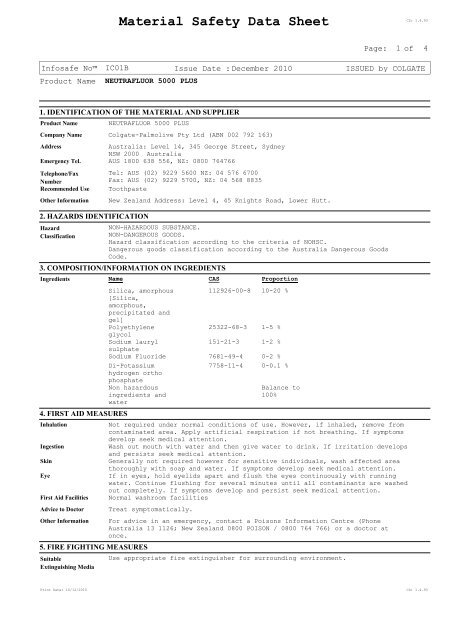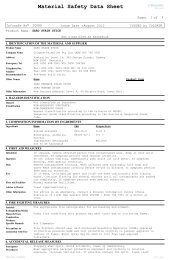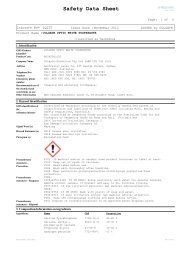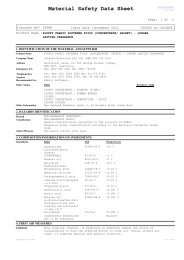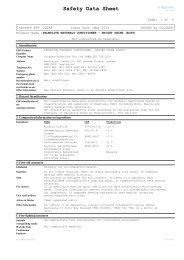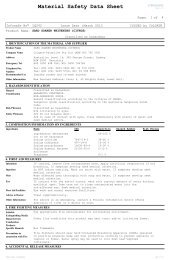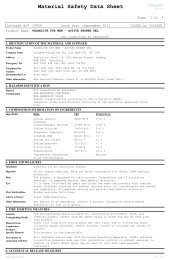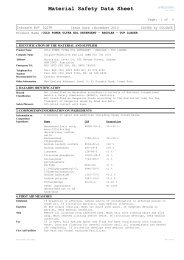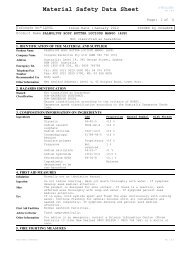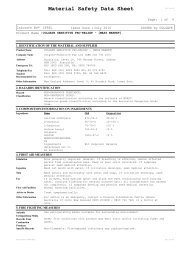Colgate Toothpaste
Colgate Toothpaste
Colgate Toothpaste
Create successful ePaper yourself
Turn your PDF publications into a flip-book with our unique Google optimized e-Paper software.
Material Safety Data Sheet<br />
CS: 1.4.93<br />
Page: 1<br />
of<br />
4<br />
Infosafe No IC01B Issue Date : December 2010 ISSUED by COLGATE<br />
Product Name :NEUTRAFLUOR 5000 PLUS<br />
1. IDENTIFICATION OF THE MATERIAL AND SUPPLIER<br />
Product Name<br />
NEUTRAFLUOR 5000 PLUS<br />
Company Name <strong>Colgate</strong>-Palmolive Pty Ltd (ABN 002 792 163)<br />
Address<br />
Australia: Level 14, 345 George Street, Sydney<br />
NSW 2000 Australia<br />
Emergency Tel. AUS 1800 638 556, NZ: 0800 764766<br />
Telephone/Fax<br />
Number<br />
Recommended Use<br />
Other Information<br />
2. HAZARDS IDENTIFICATION<br />
Hazard<br />
Classification<br />
Tel: AUS (02) 9229 5600 NZ: 04 576 6700<br />
Fax: AUS (02) 9229 5700, NZ: 04 568 8835<br />
<strong>Toothpaste</strong><br />
New Zealand Address: Level 4, 45 Knights Road, Lower Hutt.<br />
NON-HAZARDOUS SUBSTANCE.<br />
NON-DANGEROUS GOODS.<br />
Hazard classification according to the criteria of NOHSC.<br />
Dangerous goods classification according to the Australia Dangerous Goods<br />
Code.<br />
3. COMPOSITION/INFORMATION ON INGREDIENTS<br />
Ingredients<br />
Name<br />
4. FIRST AID MEASURES<br />
Inhalation<br />
Ingestion<br />
Skin<br />
Eye<br />
First Aid Facilities<br />
Advice to Doctor<br />
Other Information<br />
CAS<br />
Proportion<br />
Silica, amorphous<br />
112926-00-8 10-20 %<br />
[Silica,<br />
amorphous,<br />
precipitated and<br />
gel]<br />
Polyethylene<br />
25322-68-3 1-5 %<br />
glycol<br />
Sodium lauryl<br />
151-21-3 1-2 %<br />
sulphate<br />
Sodium Fluoride 7681-49-4 0-2 %<br />
Di-Potassium<br />
hydrogen ortho<br />
7758-11-4 0-0.1 %<br />
phosphate<br />
Non hazardous<br />
ingredients and<br />
water<br />
5. FIRE FIGHTING MEASURES<br />
Suitable<br />
Extinguishing Media<br />
Balance to<br />
100%<br />
Not required under normal conditions of use. However, if inhaled, remove from<br />
contaminated area. Apply artificial respiration if not breathing. If symptoms<br />
develop seek medical attention.<br />
Wash out mouth with water and then give water to drink. If irritation develops<br />
and persists seek medical attention.<br />
Generally not required however for sensitive individuals, wash affected area<br />
thoroughly with soap and water. If symptoms develop seek medical attention.<br />
If in eyes, hold eyelids apart and flush the eyes continuously with running<br />
water. Continue flushing for several minutes until all contaminants are washed<br />
out completely. If symptoms develop and persist seek medical attention.<br />
Normal washroom facilities<br />
Treat symptomatically.<br />
For advice in an emergency, contact a Poisons Information Centre (Phone<br />
Australia 13 1126; New Zealand 0800 POISON / 0800 764 766) or a doctor at<br />
once.<br />
Use appropriate fire extinguisher for surrounding environment.<br />
Print Date: 10/12/2010 CS: 1.4.93
Material Safety Data Sheet<br />
CS: 1.4.93<br />
Page: 2<br />
of<br />
4<br />
Infosafe No IC01B Issue Date : December 2010 ISSUED by COLGATE<br />
Product Name :NEUTRAFLUOR 5000 PLUS<br />
Hazards from<br />
Combustion<br />
Products<br />
Special Protective<br />
Equipment for fire<br />
fighters<br />
Specific Hazards<br />
Precautions in<br />
connection with Fire<br />
This product is non combustible.<br />
Full protective clothing and self-contained breathing apparatus.<br />
This product is non-combustible. However, following evaporation of aqueous<br />
component under fire conditions, the non-aqueous component may decompose<br />
and/or burn emitting toxic and/or irritating fumes.<br />
Fire fighters should wear Self-Contained Breathing Apparatus (SCBA) operated<br />
in positive pressure mode and full protective clothing to prevent exposure to<br />
vapours or fumes. Water spray may be used to cool down heat-exposed<br />
containers.<br />
6. ACCIDENTAL RELEASE MEASURES<br />
Emergency<br />
Procedures<br />
7. HANDLING AND STORAGE<br />
Precautions for Safe<br />
Handling<br />
Conditions for Safe<br />
Storage<br />
Wear appropriate personal protective equipment and clothing to minimise<br />
exposure. Increase ventilation. If possible contain the spill, spilled<br />
material is slippery. Place inert absorbent material onto spillage. Collect<br />
the material and place into a suitable labelled container. Do not dilute<br />
material but contain. Dispose of waste according to the applicable local and<br />
national regulations. If contamination of sewers or waterways occurs inform<br />
the local water and waste management authorities in accordance with local<br />
regulations.<br />
Industrial use: Use only in a well ventilated area. Keep containers sealed<br />
when not in use. Prevent the build up of mists or vapours in the work<br />
atmosphere. Avoid inhalation of vapours and mists, and skin or eye contact.<br />
Maintain high standards of personal hygiene i.e. Washing hands prior to<br />
eating, drinking, smoking or using toilet facilities.<br />
Industrial quantities: Store in a cool, dry, well-ventilated area, out of<br />
direct sunlight. Store in suitable, labelled containers. Keep containers<br />
closed when not in use. Ensure that storage conditions comply with applicable<br />
local and national regulations.<br />
8. EXPOSURE CONTROLS/PERSONAL PROTECTION<br />
National Exposure<br />
Standards<br />
No exposure value assigned for this specific material by the National<br />
Occupational Health and Safety Commission (NOHSC), Australia. However, the<br />
available exposure limits for ingredients are listed below:<br />
National Occupational Health And Safety Commission (NOHSC), Australia Exposure<br />
Standards:<br />
Substance TWA STEL<br />
ppm mg/m³ ppm mg/m³<br />
Silica, - 10 - -<br />
amorphous [Silica, amorphous, precipitated and gel]<br />
Biological Limit<br />
Values<br />
Engineering<br />
Controls<br />
Respiratory<br />
Protection<br />
TWA (Time Weighted Average): The average airborne concentration of a<br />
particular substance when calculated over a normal eight-hour working day, for<br />
a five-day week.<br />
STEL (Short Term Exposure Limit): The average airborne concentration over a 15<br />
minute period which should not be exceeded at any time during a normal<br />
eight-hour workday.<br />
Biological Exposure Indice BEI from American Conference of Industrial<br />
Hygienists (ACGIH) for ingredients are as follows:<br />
Determinant Sampling Time Biological Exposure Indice (BEI)<br />
Fluorides in urine Prior to shift 3 mg/g creatinine<br />
Fluorides in urine End of shift 10 mg/g creatinine<br />
No special engineering controls required. However under industrial<br />
applications, use with good general ventilation. If mists or vapours are<br />
produced local exhaust ventilation should be used.<br />
Not required under normal conditions. However, if engineering controls are not<br />
effective in controlling airborne exposure then respiratory protective<br />
equipment should be used suitable for protecting against airborne<br />
Print Date: 10/12/2010 CS: 1.4.93
Material Safety Data Sheet<br />
CS: 1.4.93<br />
Page: 3<br />
of<br />
4<br />
Infosafe No IC01B Issue Date : December 2010 ISSUED by COLGATE<br />
Product Name :NEUTRAFLUOR 5000 PLUS<br />
Eye Protection<br />
Hand Protection<br />
Body Protection<br />
contaminants. Final choice of appropriate breathing protection is dependant<br />
upon actual airborne concentrations and the type of breathing protection<br />
required will vary according to individual circumstances. Expert advice may be<br />
required to make this decision. Reference should be made to Australian<br />
Standards AS/NZS 1715, Selection, Use and maintenance of Respiratory<br />
Protective Devices; and AS/NZS 1716, Respiratory Protective Devices.<br />
Not required under normal conditions. However, safety glasses with side<br />
shields, goggles or full-face shield as appropriate recommended. Final choice<br />
of appropriate eye/face protection will vary according to individual<br />
circumstances i.e. methods of handling or engineering controls and according<br />
to risk assessments undertaken. Eye protection should conform with<br />
Australian/New Zealand Standard AS/NZS 1337 - Eye Protectors for Industrial<br />
Applications.<br />
Not required under normal conditions. However, under industrial applications,<br />
wear gloves of impervious material. Final choice of appropriate gloves will<br />
vary according to individual circumstances i.e. methods of handling or<br />
according to risk assessments undertaken. Reference should be made to AS/NZS<br />
2161.1: Occupational protective gloves - Selection, use and maintenance.<br />
Not required under normal conditions. However, under industrial applications<br />
suitable protective work wear, e.g. cotton overalls buttoned at neck and wrist<br />
is recommended. Chemical resistant apron is recommended where large quantities<br />
are handled.<br />
9. PHYSICAL AND CHEMICAL PROPERTIES<br />
Appearance<br />
Odour<br />
Melting Point<br />
Boiling Point<br />
Solubility in Water<br />
Light blue paste<br />
Not available<br />
Not available<br />
Not available<br />
Soluble<br />
Specific Gravity 1.30<br />
pH Value 8.0<br />
Vapour Pressure<br />
Vapour Density<br />
(Air=1)<br />
Viscosity<br />
Flash Point<br />
Flammability<br />
Auto-Ignition<br />
Temperature<br />
Flammable Limits -<br />
Lower<br />
Flammable Limits -<br />
Upper<br />
Not available<br />
Not available<br />
Not available<br />
Not applicable<br />
Non-combustible material<br />
Not applicable<br />
Not applicable<br />
Not applicable<br />
10. STABILITY AND REACTIVITY<br />
Chemical Stability<br />
Conditions to Avoid<br />
Incompatible<br />
Materials<br />
Hazardous<br />
Decomposition<br />
Products<br />
Hazardous<br />
Polymerization<br />
Stable under normal conditions of use.<br />
Not available<br />
Strong oxidising agents<br />
This product is non-combustible. However, following evaporation of aqueous<br />
component under fire conditions, the non-aqueous component may decompose<br />
and/or burn emitting toxic and/or irritating fumes.<br />
Will not occur.<br />
11. TOXICOLOGICAL INFORMATION<br />
Print Date: 10/12/2010 CS: 1.4.93
Material Safety Data Sheet<br />
CS: 1.4.93<br />
Page: 4<br />
of<br />
4<br />
Infosafe No IC01B Issue Date : December 2010 ISSUED by COLGATE<br />
Product Name :NEUTRAFLUOR 5000 PLUS<br />
Toxicology<br />
Information<br />
Inhalation<br />
Ingestion<br />
Skin<br />
Eye<br />
Chronic Effects<br />
No toxicity data available for this material. The available acute toxicity<br />
data for the ingredients as published by RTECS (Registry of Toxic Effects of<br />
Chemical Substances): are as follows:<br />
Acute toxicity data for Fluoride:<br />
LD50 (Oral, Rat): 31 mg/kg<br />
Industrial applications: Inhalation of product vapours may cause irritation of<br />
the nose, throat and respiratory system.<br />
Ingestion of this product may irritate the gastric tract causing nausea and<br />
vomiting.<br />
Not normally irritating. May cause irritation in sensitive individuals.<br />
Industrial applications: May be irritating to skin. The symptoms may include<br />
redness, itching and swelling.<br />
May be irritating to eyes. The symptoms may include redness, itching and<br />
tearing.<br />
Not available<br />
12. ECOLOGICAL INFORMATION<br />
Ecotoxicity<br />
Persistence /<br />
Degradability<br />
Mobility<br />
Environ. Protection<br />
No ecological data available for this product.<br />
Not available<br />
Not available<br />
13. DISPOSAL CONSIDERATIONS<br />
Disposal<br />
Considerations<br />
14. TRANSPORT INFORMATION<br />
Transport<br />
Information<br />
15. REGULATORY INFORMATION<br />
Regulatory<br />
Information<br />
Poisons Schedule<br />
16. OTHER INFORMATION<br />
Date of preparation<br />
or last revision of<br />
MSDS<br />
Contact Person/Point<br />
Prevent release of large quantities to the environment.<br />
Industrial applications for large quantities: The disposal of the spilled or<br />
waste material must be done in accordance with applicable local and national<br />
regulations.<br />
Not classified as Dangerous Goods according to the Australian Code for the<br />
Transport of Dangerous Goods by Road and Rail. (7th edition)<br />
Not classified as Hazardous according to criteria of National Occupational<br />
Health & Safety Commission (NOHSC), Australia.<br />
Classified as a Scheduled Poison according to the Standard for the Uniform<br />
Scheduling of Medicines and Poisons (SUSMP).<br />
S3<br />
MSDS Reviewed: December 2010<br />
Supersedes: September 2005<br />
24Hr Emergency Response<br />
Australia- 1800 638 556<br />
New Zealand- 0800 764 766<br />
...End Of MSDS...<br />
© Copyright ACOHS Pty Ltd<br />
Copyright in the source code of the HTML, PDF, XML, XFO and any other electronic files rendered by an Infosafe system for Infosafe MSDS displayed is the intellectual<br />
property of Acohs Pty Ltd.<br />
Copyright in the layout, presentation and appearance of each Infosafe MSDS displayed is the intellectual property of Acohs Pty Ltd.<br />
The compilation of MSDS's displayed is the intellectual property of Acohs Pty Ltd.<br />
Copying of any MSDS displayed is permitted for personal use only and otherwise is not permitted. In particular the MSDS's displayed cannot be copied for the purpose of<br />
sale or licence or for inclusion as part of a collection of MSDS without the express written consent of Acohs Pty Ltd.<br />
Print Date: 10/12/2010 CS: 1.4.93


